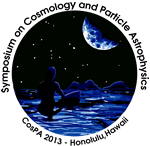Speaker
Dr
Haipeng An
(Perimeter Institute)
Description
Light new particles with masses below 10 keV, often considered as a plausible extension of the Standard Model, will be emitted from the solar interior, and can be detected on the Earth with a variety of experimental tools. Here we analyze the new "dark" vector state V, a massive vector boson mixed with the photon via an angle kappa, that in the limit of the small mass m_V has its emission spectrum strongly peaked at low energies. Thus, we utilize the constraints on the atomic ionization rate imposed by the results of the XENON10 experiment to set the limit on the parameters of this model: kappa times m_V< 3 times10^{-12} eV. This makes low-threshold Dark Matter experiments the most sensitive dark vector helioscopes, as our result not only improves current experimental bounds from other searches by several orders of magnitude, but also surpasses even the most stringent astrophysical and cosmological limits in a seven-decade-wide interval of m_V.
Primary authors
Dr
Haipeng An
(Perimeter Institute)
Dr
Josef Pradler
(Johns Hopkins University)
Prof.
Maxim Pospelov
(Perimeter Institute and University of Victoria)

